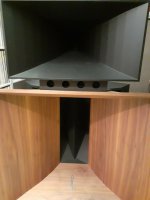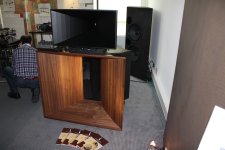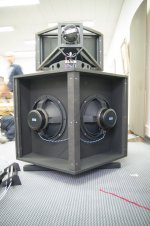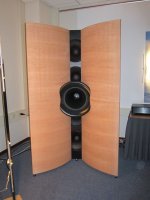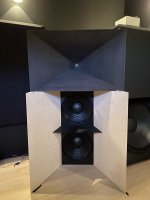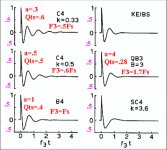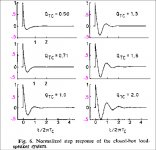Informative posts GM!
I still believe a large 2 way, crossed around 500Hz, should suit most needs.
With the exception of dedicated subwoofer drivers, most 15" woofers are devoid of IMD, nodal resonances, radial modes etc. when operated over a limited bandwidth. Horn loading dual 15 woofers further improve things.
Together with the previously mentioned horn loaded OB Bass array from BD-Design, this 2 way should also meet the thread title:
I still believe a large 2 way, crossed around 500Hz, should suit most needs.
With the exception of dedicated subwoofer drivers, most 15" woofers are devoid of IMD, nodal resonances, radial modes etc. when operated over a limited bandwidth. Horn loading dual 15 woofers further improve things.
Together with the previously mentioned horn loaded OB Bass array from BD-Design, this 2 way should also meet the thread title:
Attachments
Last edited:
I still believe a large 2 way, crossed around 500Hz, should suit most needs.
With the exception of dedicated subwoofer drivers, most 15" woofers are devoid of IMD, nodal resonances, radial modes etc. when operated over a limited bandwidth. Horn loading dual 15 woofers further improve things.
I agree with you here. But, I do think that dual 15s is over kill and "horn loaded" is more appearance than performance. For PA this might be required but, for the most part here at DIY it's home use only.
Up to now and for the unforeseeable future I'll be using a 15" direct radiator + horn/waveguide, similar to the Summa (still experimenting with different woofers and horns).
After experiencing FLH's magical mid-bass, space permitting, I might pull the trigger on something like the system above, or the BD-Design Orelo.
However, I'll definitely use a constant coverage horn, like some Norwegians do (2nd pic.).
After experiencing FLH's magical mid-bass, space permitting, I might pull the trigger on something like the system above, or the BD-Design Orelo.
However, I'll definitely use a constant coverage horn, like some Norwegians do (2nd pic.).
Attachments
Last edited:
It is possible that a scientifically correct speaker can sound good just because they look scientifically correct for him. We're all biased by what we believe in reality...
Again, the lower the Fs, the wider its harmonic BW, ergo Dc = infinite BW.
For this reason the lower the system's Fs, the 'fuller', more 'extended' we perceive the whole BW whether or not the HF is equally balanced [extended] and apparently why the pioneers designed speakers tuned somewhat below the lowest notes on the recordings.
Conversely, if the HF signal is prominent up to 20+ kHz our brain will reconstruct a rolled off low end and one reason why some folks claim we ideally need up to 40 kHz systems.
When I engage with some of you, its like dancing with a professional dancer and I am stepping on your toes watching you cringe but trying to remain positive lmao! GM and Geddes in particular, tend to be rather technical... Thank you all for continuing to dance with me.
So I just brought myself back up to speed (I think) using horn resp.... For lower bass drivers.... I still am onboard with what Earl said about excursion and power being the most important factors for bass.
I am not seeing any time to peak energy or decay artifacts due to driver fs(fc) in the sealed box. With a vent, the Fb has both...just saying. Driver power efficiency does surround Fc and Fb. I guess that if we could ever hear the drivers resonant note, it would be due to lack of power compression in that area?
Attachments
Last edited:
GM and Geddes in particular, tend to be rather technical...
Designing loudspeakers is rather technical isn't it? I don't know of another way to do it.
More eye candy than science IMO.
Not entirely true, the first system sounds entirely different than a closed or BR cabinet.
OB with decoupled horn mouth works wonders for acoustic music. That system is quite effective at reducing room influences.
However, I do appreciate the forceful bass of a properly tuned and damped BR cab, especially with electronic music.
One thing that I did not 100% embrace in the past was the idea that room Q dominates (add in the ambiguous use of the term, driver compliance vs roll off characteristics) This is still the case in nearfield? My next thought was well then room spectral decay dominates as well...might as well throw in room resonate note as well...Call it Fr? I guess this is why excursion and power matter more than Fs!
What is the ratio of perception at nearfield, in particular 1m...Direct vs Room?
It has been my theory that I could fight against the room using direct energy via close proximity and large source size. How much of a dent am really I making?
What is the ratio of perception at nearfield, in particular 1m...Direct vs Room?
It has been my theory that I could fight against the room using direct energy via close proximity and large source size. How much of a dent am really I making?
Last edited:
I guess this is why excursion and power matter more than Fs!
Hello Camplo
Are you or have you considering assisted alignments? As long as you have the power handling and excursion they can work quite well and extend your response significantly. Example would be JBL B380 with a Q2 +6dB @ 26Hz at box tuning frequency.
I use that same alignment with 2216nds and it changes the F3 from 47Hz to 25Hz.
Rob🙂
Well the plan has been to sculpt the desired low end response with eq... what is an assisted alignment.
One thing that I did not 100% embrace in the past was the idea that room Q dominates (add in the ambiguous use of the term, driver compliance vs roll off characteristics) This is still the case in nearfield? My next thought was well then room spectral decay dominates as well...might as well throw in room resonate note as well...Call it Fr? I guess this is why excursion and power matter more than Fs!
What is the ratio of perception at nearfield, in particular 1m...Direct vs Room?
It has been my theory that I could fight against the room using direct energy via close proximity and large source size. How much of a dent am really I making?
As to your questions about field position, I can't be clear on how you are using the terms "direct field" and "Near field". They are completely different things. If you are talking about the direct field (where the direct sound is equal to the reverberant sound level) then yes, I agree with what you are saying, it's basically what I have been saying for a long time.
First, the speaker Q (I am not sure that your Q is the same as mine, mine means the directivity Q) is dominate in the location of the direct field transition, the higher the Q the farther is the direct field. This does diminish the perception of the room (I am talking above Schroeder fS here.) This is why I say that high Q speakers are preferred IMO.
Below fS, your "Fr" does in fact dominate everything, which is why I say that nothing beyond power and excursion matters. It's source placement and EQ that matter and specifics of the subs (Fs, Q, Cms, alignment etc.) are irrelevant (except for the above two factors.)
These have been design principles of mine for many decades.
PS. For woofers used in 2-ways, how a 15" handles HFs is a major concern of course.
Well the plan has been to sculpt the desired low end response with eq... what is an assisted alignment.
Here this explains it all.
1983 JBL SUBWOFFER DESIGN
Rob🙂
Many Q values exist, both driver- and cabinet-related, but I guess camplo is referring to either box Q or Qtc (for sealed).
As to your questions about field position, I can't be clear on how you are using the terms "direct field" and "Near field". They are completely different things. If you are talking about the direct field (where the direct sound is equal to the reverberant sound level) then yes, I agree with what you are saying, it's basically what I have been saying for a long time.
First, the speaker Q (I am not sure that your Q is the same as mine, mine means the directivity Q) is dominate in the location of the direct field transition, the higher the Q the farther is the direct field. This does diminish the perception of the room (I am talking above Schroeder fS here.) This is why I say that high Q speakers are preferred IMO.
Below fS, your "Fr" does in fact dominate everything, which is why I say that nothing beyond power and excursion matters. It's source placement and EQ that matter and specifics of the subs (Fs, Q, Cms, alignment etc.) are irrelevant (except for the above two factors.)
These have been design principles of mine for many decades.
PS. For woofers used in 2-ways, how a 15" handles HFs is a major concern of course.
Direct field is a new term for me, in regards to a 50/50 of direct sound vs reverberation sound, I did not know that it had a name... Asking where this distance is, is probably not productive. It may be better to ask how to determine this distance from the loudspeaker. Or maybe how to assume how much direct energy I am getting vs how much reverberation I am getting at mic position.
Last edited:
I think I am there already but my approach is unique and not unique at the same time....
I am to use eq to sculpt the response already...Instead of adding a low tuned port....I added another woofer. With this approach performance is better than a single woofer plus port. I don't know if this is worth naming....I pulled on a funny on board to claimed to add "active radiator technology" to my design, stating how it was superior to vents and passive radiators...in particular with group delay and decay figures staying that of a sealed box...I stand by my claims...
I wonder if some kind of isobaric configuration could be made using a purposefully tuned line in between. Let me guess...the pioneers tried it already.....🙄
Direct field is a new term for me, in regards to a 50/50 of direct sound vs reverberation sound, I did not know that it had a name... Asking where this distance is, is probably not productive. It may be better to ask how to determine this distance from the loudspeaker. Or maybe how to assume how much direct energy I am getting vs how much reverberation I am getting at mic position.
It is called critical distance. Here is a calculator to guess/estimate it.
RT60 - Distance critique
Room dimensions have to be in meters, reverb time at 2khz is needed ( try 0,2 to 0,4s).
Last edited:
krivium - With a large system at 1 meter, can you hypothesize the ratio or is it too strongly related to room size?? I've read elsewhere that a 50/50 relation ship is desirable but I don't know of Dr Geddes to set his systems up in nearfield...then again I am not sure exactly what his listening distance is....Earl? I feel strange addressing a person by name when they don't know mine =/ mine is Courtney lol!
Last edited:
- Home
- Loudspeakers
- Multi-Way
- Is it possible to cover the whole spectrum, high SPL, low distortion with a 2-way?
